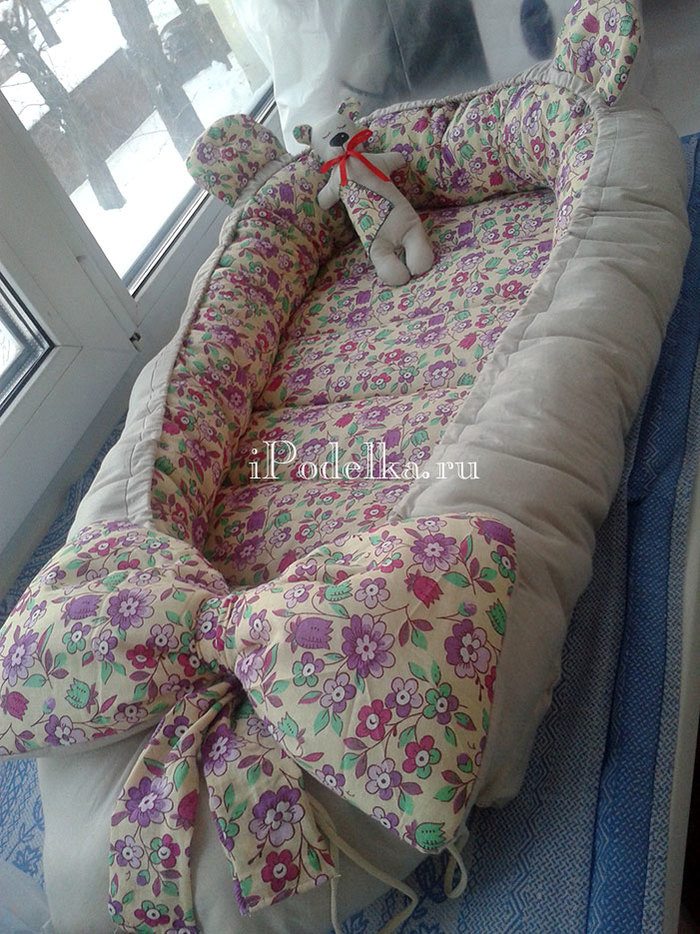To keep your baby warm and comfortable in the first months of life, he needs a special cocoon. It can be in the form of an envelope or a diaper. In addition, it is so convenient to rock and carry the baby in it. You can make excellent cocoons for newborns yourself.
What is a cocoon and what is it for?
First of all, this thing was created as an alternative to an ordinary rectangular diaper. In shape, it resembles a long knitted hat or a sewn envelope with wraparound edges. Of course, the cocoon should be made only from natural fabrics.
In these situations, children have "contact" sleep. The baby sleeps better, longer and cries less often. The desire to reduce crying time is often a priority and makes us forget what we know about these positions, which should not be held for too long and are indispensable for digestion, breathing and posture.
5th article in the plagiocephalic series: buns. 3rd article in the plagiocephalic series. Another simple biomechanical observation. We have separated this biomechanical observation from the first three. Because now the shape of the head support is no longer flat, but inclined. This is what happens when we put a baby in a cozy, cocoon, chaise longue, ottoman, or if we pull out a pillow, tilt or hold system under his head. Babies assume positions that resemble those of a fetus and cause symbolic images comfort, softness and safety.
It is much more convenient for a child to be in such a cozy bag than in tightly tucked diapers. You can stretch your legs and move around. It will also be much easier for parents to put the baby in a cocoon with one or two movements, rather than perform complex swaddling manipulations.
There are also liners for a baby crib. In any case, it will be convenient for both you and the baby. In stores, you can find a variety of cocoons for newborns, but they are usually very expensive. The thing will be used for a maximum of the first four to five months, so what's the point of throwing away money that is better spent more rationally? It is quite possible to make a cocoon for newborns with your own hands.
But is this extension of the fetal position, such as the 4th trimester of pregnancy, so good for the baby? Consider the mechanical effects and intensity of the forces this position imposes on the skull, neck, neck tissues, and body posture in general. We have already seen that with flat support, when the child has an axial head, it is curved and projected forward.
At the rear, forces applied to the area of contact are increased and tension will be increased in all tissues of the neck and upper back. This position in the bend of more or less the head also results in a contraction in the length of the muscles that allow rotation of the head. The head will remain even calmer.
- At the front, the neck disappears passively more or less completely.
- The cervical space is closed and under tension.
- These muscles will make it harder to be active.
First you need to decide what it should be. This is influenced primarily by the time of year. If the child was born in winter, respectively, the cocoon for him should be insulated. It’s better to do the pattern yourself, since no one but you knows what is right for you. If you plan to carry your child in a cocoon for walks, make an additional pocket on the back side where you can put a mattress. Perfect for a stroller. A very convenient option is when the envelope unfolds into a blanket.
It will run away from the stretching tension felt at the back of the head. His the only solution is to passively turn on one side and tilt it to the other side. But it's not without creation side effects. The digestive and respiratory tissues of the front of the neck will be twisted. During sleep phases, a more hypotonic child may pass head first passively.
First of all, it is a position that exactly contributes to the flattening of the lateral part of the back of the skull, which we find in postpartum postural plagiocephaly. You can observe two twins in a comfortable head position. To the right, with a much longer skull, each of them sought a comfortable position between the side holds.
So, a cocoon envelope for a newborn should be strictly made from natural materials. Best for winter version artificial or natural fur, for the inner layer - flannel or calico. You can also use velvet, fleece and plush. The insulated model should additionally have a layer of synthetic winterizer, holofiber or wool.
Answer the question of the day. Does my child still love being in the ball? Could it be awkward? In the first weeks, it is quite normal for the baby to maintain a position that is a continuation of the life of the fetus, flexion and repositioning. Finding her postural references is soothing and soothing to a child who has been confronted by heaviness since birth.
However, this general form head and body does not inform us about the child's freedom of movement in order to be able to adopt positions adapted or imposed by his new living conditions. Schematically, the body of a newborn consists of the sum of the expressed volumes to each other. This amount balloons will take place during pregnancy or during childbirth mechanical stresses of stretching, compression, cutting. These soft or strong forces leave various imprints of tissues in the body.
The most optimal size for a cocoon envelope is about eighty to fifty. But remember that inside should not be too free, its main purpose is to warmly wrap the child.
For the smallest children, you need to sew an envelope with special side lapels that will help swaddle the handles.
How to sew a simple cocoon
The most elementary option that does not require a lot of time is a regular envelope without lapels. By itself, it will consist of three layers - internal, insulation and external. Cut out the pattern in the form of a rectangle of the desired size. Keep in mind that you will make a lapel from below. Place the insulation between two layers of fabric and sew the pattern on the sewing machine. Now fold it in half, retreating twenty to twenty-five centimeters from above. Sew zippers on the sides. Form a hood from the top. Everything, a simple cocoon envelope for a newborn is ready.
What is a cocoon nest for newborns
The newborn will have to fight the gravity that the plate is on the ground and against certain positions that create muscle tension, some movements will be difficult to achieve. Many infants will not be able to support a lying flat because their body will have to open up under the force of gravity and this will create uncomfortable tension. When we find that the lumbar region flexes on its own, it is possible that the child has constipation. If a child has a sucking problem, compression between the skull, neck, and chest is very common.
We sew a more complex version
Keep in mind that the size of the main canvas should always be larger, as it forms an envelope according to the dimensions you specify. You can make a universal option for spring, when the weather is changeable from warm to cold.
In addition to fabric and insulation, you will need a regular and detachable zipper, as well as additional material for pocket. The sewing principle will be the same, but with some changes. You will have a separate pattern for the main envelope and for the pocket with insulation. It will just need to be stitched from the front side inside, under the back of the baby. You can make it removable by pushing it in or pulling it out as needed. Sew a detachable zipper on the sides and bottom, and use the regular zipper for the hood.
The child has a frog. If the head cannot flex at the neck, it will make the sleeping position uncomfortable if the support is raised, as in a chair. A compressed pelvis on the lower back will not twist and may impair or delay the acquisition of stomach rotation. The fixed body in the form of a comma creates tension on the head and promotes easy breastfeeding on one breast on the closed side and makes it difficult to work with the other breast. The general tension of the spherical body in the tonic womb will increase the child's reactivity threshold, he will cry much easier and more often.
Cotton cocoon with buttons
Very convenient option for walks in the spring. You will need cotton fabric for the outer layer, fleece for interior decoration and synthetic winterizer for insulation. As well as buttons and trim five centimeters wide.
The product will consist of three layers - top cotton, synthetic winterizer insulation and inner fleece. You can sweep all the layers with a thread by hand so that they do not diverge. After stitching, turn the cocoon inside out. Now you need to sew the trim around the edge. It will protect the fabric from spreading, and the envelope will keep its shape. Separately make a strip of fabric with holes for buttons on both edges. Its length should correspond to the front outer side of the cocoon. Sew buttons on the sides. Thus, the edges of the envelope will be fastened in the middle.
We will not be able to open, close and rotate the body, as when we play the accordion. We could list long list movement restrictions that can affect the child's quality of life and comfort. The child is often, naturally, in the fetal position, but he must be able to freely close or open his body, lie down, etc. all these movements should be checked, if they are limited or asymmetrical, they should be corrected. The change in the mobility of the child's body should be visual to the parents during the session.
sleeping bag cocoon
This option is ideal for winter, so it is better to use natural fur fabric. You will also need lightning. Cut a piece of fabric to the desired size, taking into account the fold in half and the seams. The fabric needs to be sewn from the wrong side, so we turn it inside out with the fur.
 Unlike the previous options, here you do not leave an edge for the hood. That is, you completely sew the edges on all sides, leaving two centimeters, except for the bottom one - do not touch it yet. It is important. Work well on all edges, remember that this will be the inside of the cocoon, and nothing should create discomfort. Sew a zipper into the bottom. Make a hole for the face on one side. It can be round or semicircular. Also process its edges by bending two centimeters. You can insert a lace or elastic band into this hem.
Unlike the previous options, here you do not leave an edge for the hood. That is, you completely sew the edges on all sides, leaving two centimeters, except for the bottom one - do not touch it yet. It is important. Work well on all edges, remember that this will be the inside of the cocoon, and nothing should create discomfort. Sew a zipper into the bottom. Make a hole for the face on one side. It can be round or semicircular. Also process its edges by bending two centimeters. You can insert a lace or elastic band into this hem.
4th article in the series. #2 Next article Transat, cozy, cocoon, ottoman. The goal is for children to feel comfortable in comfort and warmth without risking being discovered or, conversely, staying closed face. Sleeveless this sleeping bag, but this time there is a sewing zipper. It can be made from hot cotton, fleece and even lightly quilted.
Nana padded sleeve with buttons
This is one of the most simple ways make your own. In practice, it's just a square in the fabric that zips up and folds. different ways. For very young children, it may be helpful to have a sleeping bag that completely wraps them. It is made into a bag at the entrance and two flaps overhanging and closing to tear at the top. To do this, follow the explanations.
Fur cocoons for newborns are really warm and cozy. Making them is extremely simple for any woman who has at least basic sewing skills.
Fur envelope for baby
If this is the first time you are going to sew a cocoon for newborns, the feedback from the forums can be of great help to you. As a rule, young mothers are of the opinion that it is still better to do it yourself, because a really high-quality envelope or mattress can be very expensive, and you will not use it for a long time.
We sew a diaper cocoon
Do you know how to crochet this lovely sleeping bag? The model is designed to work on crochet only a rectangle, which will then be folded and buttoned at the sides. In this case, we used a braid point and a coast point, but can also be created with other points. Look here → Crochet Crochet Bag.
Do you have so many wool sweaters that you no longer wear? Use it to make your own sleeping bags. Just a few shots with scissors and a few stitches, etc. the bag is ready, free and redesigned! Tutorial here → Sleeping bag with sweater.
Sewing a fur envelope will be a little more difficult, but we take the first option for making a cocoon like a sleeping bag as a basis. The main difference is that the zipper will be in the middle - so it will be more convenient for you to pull out the baby.
So, the fabric is turned inside out with fur. Position the zipper in the middle and cut out a hole for the face. After you process all the edges, except for the bottom one, and sew in the zipper, turn the cocoon inside out with the fur. You can also insert an elastic band or drawstring into the hood for tightening.
We met with prof. Dr. Emilia Hristova, founder and first president of the Bulgarian Association of Neonatologists, member of the European Association of Neonatologists. She told us about the newborn nests used in French neonatal clinics and wards, and the views of the world's neonatal schools on the position of the newborn in bed.
Question: Can you tell us a little about the history of these newborns? Maternity departments and clinics in the country equipped with equipment and by human resourses, in accordance with the standard medical standard for neonatology. At the third level, there are six neonatological units and thirty neonatological units of the second level. The time has come to consider the quality of neonatal care, which also includes the creation comfortable conditions for sleeping and waking newborns, especially risky newborns.
 If you want to make your envelope more fun, sew applications on its front side. You can give it any shape. For example, make ears or antennae, like a bee. In general, anything, the main thing is to turn on the imagination.
If you want to make your envelope more fun, sew applications on its front side. You can give it any shape. For example, make ears or antennae, like a bee. In general, anything, the main thing is to turn on the imagination.
We make a comfortable cocoon diaper for the little ones
It can also be made by anyone, regardless of their skills and sewing skills. The diaper-cocoon for newborns is different in that it has two lapel edges. Its pattern will resemble the letter "T". Separately make a pattern for the pocket.
Why is it called a nest or a cocoon?
I had the opportunity to do my specialization back in the 80s of the last century and be part of a scientific team that developed sleep problems in high-risk newborns. The proposed "nests" turned out to be very appropriate, especially for children with respiratory rhythm disorders, children with gastroesophageal reflux. Exactly these scientific results these children were used in conventional French neonatal practice. In our country, in the conditions of the economic crisis, priority was given to resuscitation tables and incubators in the first place.
This option is not for carrying, but simply for swaddling, so a regular flannel is taken for inside and pockets, and jersey (or cotton) for the outside. Take the zipper longer, according to the size of the product.
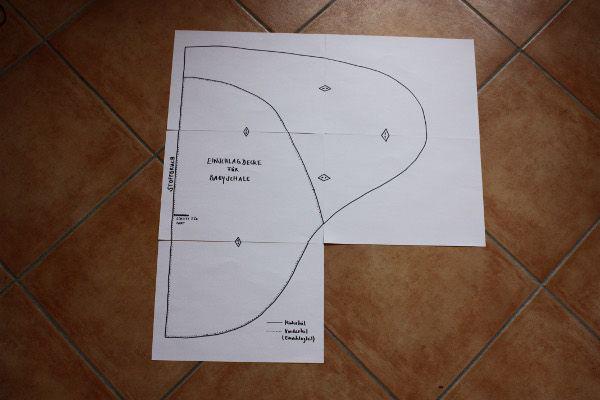 So, the first stage. It is necessary to cut out a sketch of a cocoon according to the pattern, both from cotton and from flannel. If you will make the outer layer of knitwear, be sure to get an inlay, without it your product will very quickly spread and lose its shape.
So, the first stage. It is necessary to cut out a sketch of a cocoon according to the pattern, both from cotton and from flannel. If you will make the outer layer of knitwear, be sure to get an inlay, without it your product will very quickly spread and lose its shape.
Why is it worth buying such a cocoon?
It's time to think about accessories that improve the adaptation of newborns and provide a position for better lung function. Q: Do Bulgarian neonatologists have these nests? Some hospitals, where the budget allows, can boast these products very soon. For a premature baby, it is important to put him in best conditions closest to the position in which he was in the womb. This positioning, for example, leads to a significant reduction in the effect of gastroesophageal reflux.
The top and bottom sides need to be stitched together, leaving room at the bottom. Otherwise, you will not be able to turn the cocoon with the seams inward. Now your task is to connect the pocket to the base with a zipper. But first, grab it on one side by three centimeters. Now sew on the clasp. So a comfortable diaper-cocoon for newborns is ready. It is not difficult at all, the main thing is to do everything carefully and slowly.
Usually in children with reflux, we recommend raising the bed level off the head to get about a 30 degree slope. Especially valuable placement of children with neonatal respiratory pauses and apnea. Head position is essential and reduces the risk of sudden death syndrome. With the nest, not only comfort is achieved, but also the ability of the newborn to move, to touch his face with his hands, as in the womb, to get a sense of security, his sleep becomes more restful and longer. It is the reduction of stress, crying and insecurity that is the purpose and convenience of the nest.
Crochet cocoon for newborns
This is not just a product designed to simplify swaddling for mom and create comfort for the baby. A knitted cocoon can be very beautiful and openwork, so your baby will look like an angel from a postcard in it.
Unlike the methods described above, such a cocoon is hardly suitable for walking. Except in summer time when the weather is already warm outside, or instead of diapers.
How to knit a diaper nest
In fact, the nest is not a luxury, but a well-designed product that works for the comfort of a newborn. The creators of this concept observed the development of preterm newborn babies who were in the usual erect position, looking at the ceiling or the preferred side taken in the mother's abdomen. From the analysis of the results after years of research confirmed positive influence to use the socket. At a later stage, newborn babies find themselves in such nests in their home environment, and their use continues until the age is changed to 4 months.
The scheme of a cocoon for newborns, crocheted or knitted, is taken the same as for a hat. It just makes it bigger and much longer. By the way, why not tie a nice little hat to your elegant cocoon? What is the convenience of a knitted cocoon compared to diapers? It is warm, comfortable and does not require additional fixation.
The observations of doctors and social workers over the years and the positive impact of the nest on the quality of life of preterms encourage the creators of the concept of the idea to seek cooperation for laboratory analysis and find the most suitable product for the production and commercialization of the nest. small company from the south of France invested money and effort and many years ago the result came to an end - the increasing use of nests in neonatological units, equipping all maternity wards with sponsors, municipalities, private and government agencies.
 So, take the yarn you like and the average thickness of the hook. Knit the first braid of the desired size and connect its ends. Make a connecting post for the next row. Next, cast on about three air loops, knit six double crochets. The next row is the same number of air loops and two double crochets. Further, the cocoon will expand. In the next rows, add about eight loops evenly. It is thanks to this that your product will become larger, which is what you need. When you realize that further expansion is no longer needed, continue to knit the same number of columns to the end. Separately, you can knit decorations and then just sew them on.
So, take the yarn you like and the average thickness of the hook. Knit the first braid of the desired size and connect its ends. Make a connecting post for the next row. Next, cast on about three air loops, knit six double crochets. The next row is the same number of air loops and two double crochets. Further, the cocoon will expand. In the next rows, add about eight loops evenly. It is thanks to this that your product will become larger, which is what you need. When you realize that further expansion is no longer needed, continue to knit the same number of columns to the end. Separately, you can knit decorations and then just sew them on.
We knit a cocoon for newborns with knitting needles
It will seem easier for someone to knit. A feature of knitting is a denser texture. If the yarn is prickly, another simple cotton or flannel cover can be placed separately inside. Such a knitted cocoon for newborns is suitable as a replacement for diapers or additional insulation during winter walks. It can be made both open and as a sleeping bag. Don't overdo the patterns. Remember that the baby's skin is still very delicate, and any irregularities can cause him discomfort.
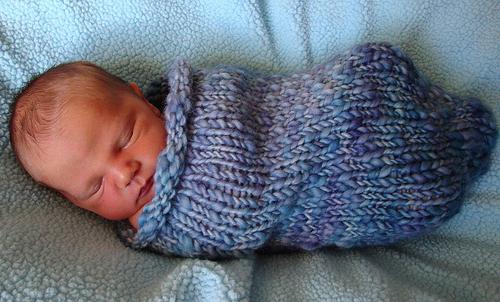 Needles number five or six will be optimal. Cast on approximately seventy-five stitches. Knit the first row completely, and purl the second row. The third one starts with the edge. Now start counting. Five facial out of five per pattern twelve times, facial, purl. The next row is all purl. Behind him - all facial. Continue in regular garter stitch. To expand downwards, add a loop on each side. To make a bag, you will need additional knitting needles. Here you will need to decrease each time through a smaller number of loops - first six, then five, and so on up to two. In the holes left from the circular knitting, you can thread a beautiful lace or ribbon. Ready!
Needles number five or six will be optimal. Cast on approximately seventy-five stitches. Knit the first row completely, and purl the second row. The third one starts with the edge. Now start counting. Five facial out of five per pattern twelve times, facial, purl. The next row is all purl. Behind him - all facial. Continue in regular garter stitch. To expand downwards, add a loop on each side. To make a bag, you will need additional knitting needles. Here you will need to decrease each time through a smaller number of loops - first six, then five, and so on up to two. In the holes left from the circular knitting, you can thread a beautiful lace or ribbon. Ready!
How to make a comfortable diaper-cocoon with Velcro
The variant with a T-shaped pattern is taken as the basis. In fact, they are distinguished from each other by the presence of Velcro. To make your pocket fit like a glove, outline the bottom of the main pattern for the pattern. Carefully choose Velcro, remember that the most important thing is comfort for the baby. They should be soft and elastic. Sew one Velcro on the outside of the right lapel, and the second on the inside of the left. Or vice versa, as it will be more convenient for you to fasten them later.
 Well, you have learned how to make cocoons for newborns on your own and different ways. It remains only to understand which one will be the most optimal for you. Or maybe you want to make several at once, because they are quite simple to manufacture.
Well, you have learned how to make cocoons for newborns on your own and different ways. It remains only to understand which one will be the most optimal for you. Or maybe you want to make several at once, because they are quite simple to manufacture.
AT recent times the so-called cocoons for newborns became very popular. And it’s really a very practical thing, it’s a pity when I gave birth to my son, no one threw the idea of such a universal mattress. I had to roll a blanket into a roll, so as not to accidentally “press down” when I was sleeping next to me. Look for different uncomfortable positions to feed, and here the baby’s personal space is not violated and you can put the head on the side to feed calmly
It's good that my girlfriends continue to give birth to babies, and I can give them such charming cocoons - mattresses.
In this article I will tell you how to sew a cocoon for a newborn with your own hands with step by step unique photos. It's not as difficult as it seems. The article is accompanied by a pattern and a scheme for sewing toys - "splyushka" and a cocoon - a very useful thing for every mom and her baby.
Everyone can sew such beauty if there is a desire. To do this, you need a minimum set: fabric (chintz or calico) 120 cm with a width of at least 140 cm, filler (synthetic winterizer 2 cm thick or 700 grams of holofiber), 2 m of cord, matching threads, household sewing machine.

According to the provided scheme, make a pattern on the fabric.

From the remnants of the fabric, cut out a ribbon 4 cm wide, ears.

Put all the details together. Mark the places for attaching parts. Sew along the perimeter. Leave a small opening at the bottom for eversion (section VG). Turn out, iron.
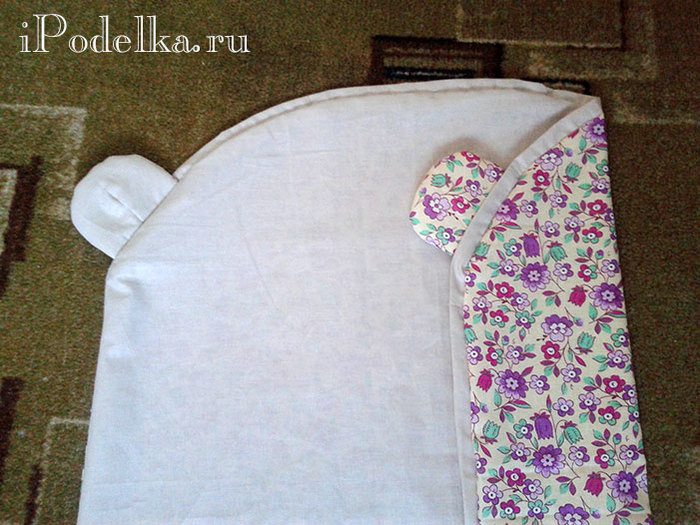

Stitch the canvas along the inner contour, leaving the AB segment open through which we will further insert the padding polyester roll - this is a painstaking task, but doable.
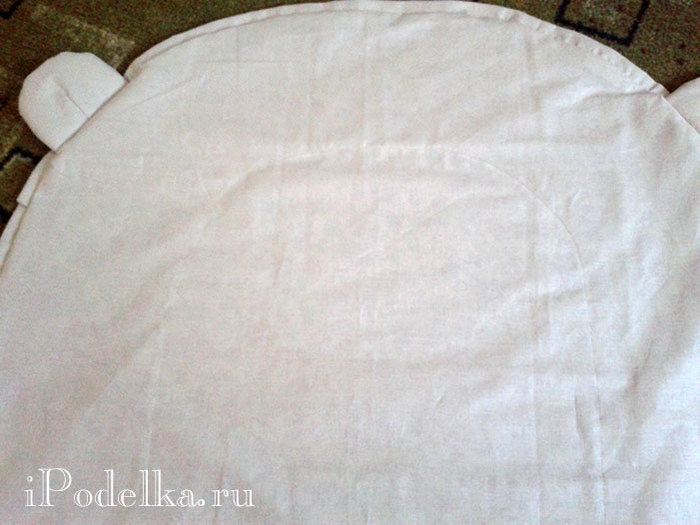
After the roll is inserted into the side, sew up the hole. Cut out a detail from a synthetic winterizer repeating the contour of the "bed".
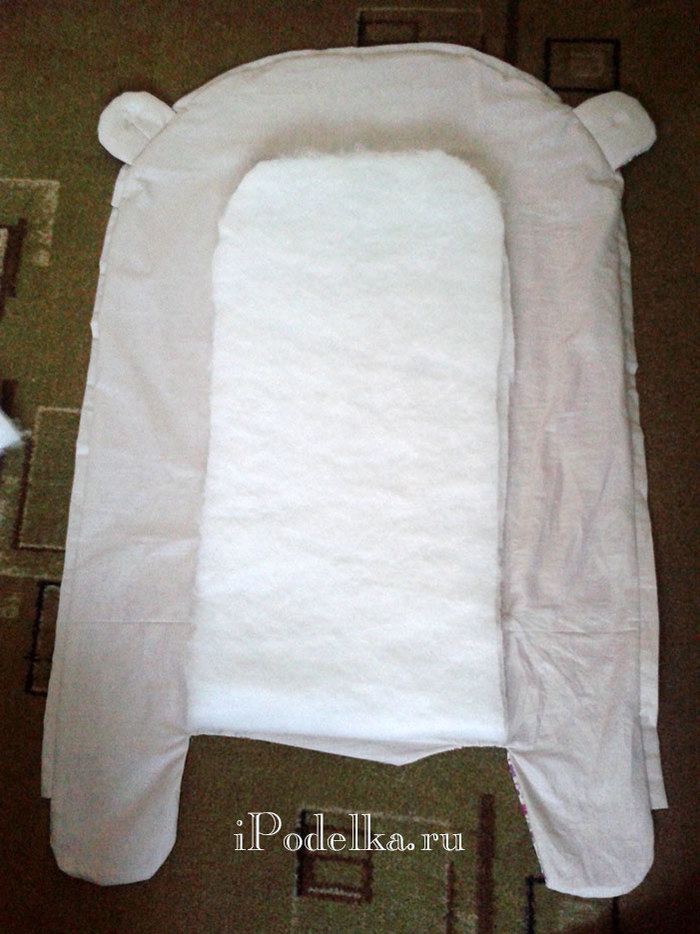
Insert it into the formed pocket and sew up the hole. Make a transverse stitching to fix the synthetic winterizer inside. Insert cord. Adjust the length as desired.
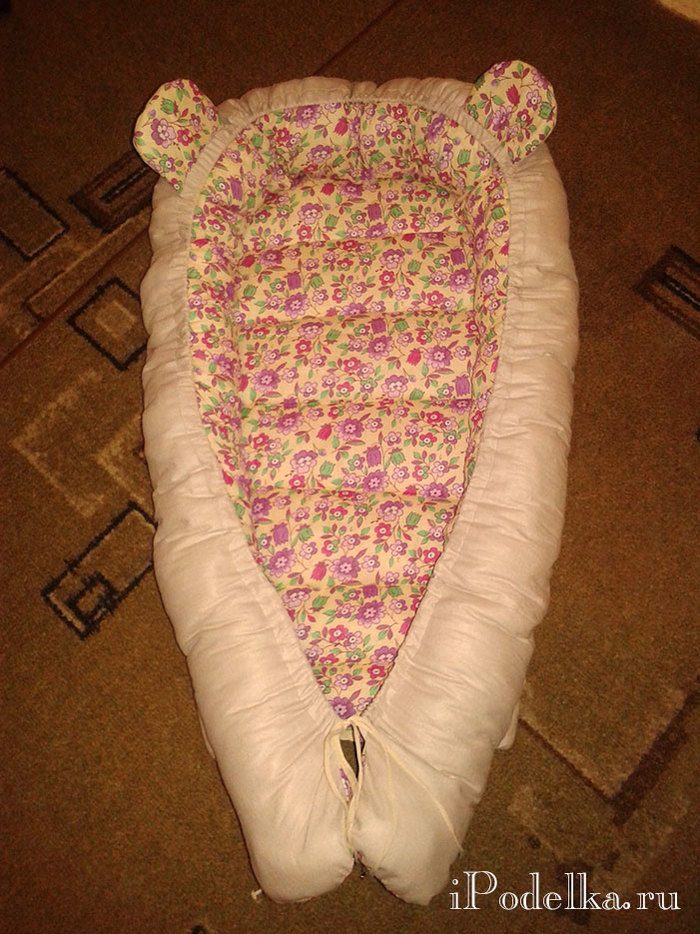
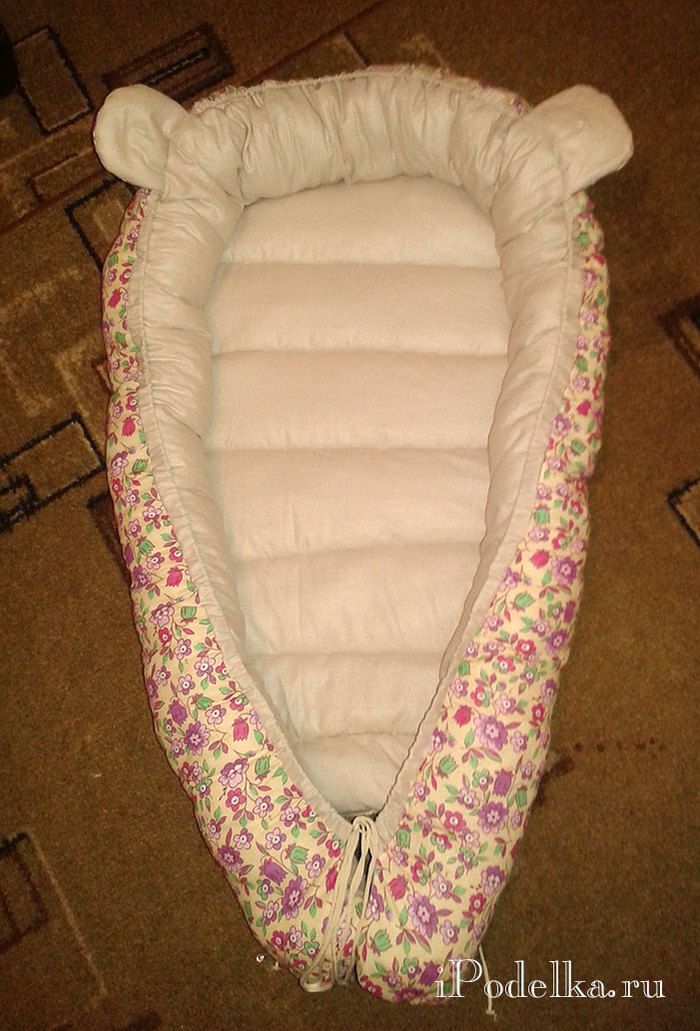
The cocoon is ready, but you can decorate it chic bow from the remnants of fabric and synthetic winterizer.
